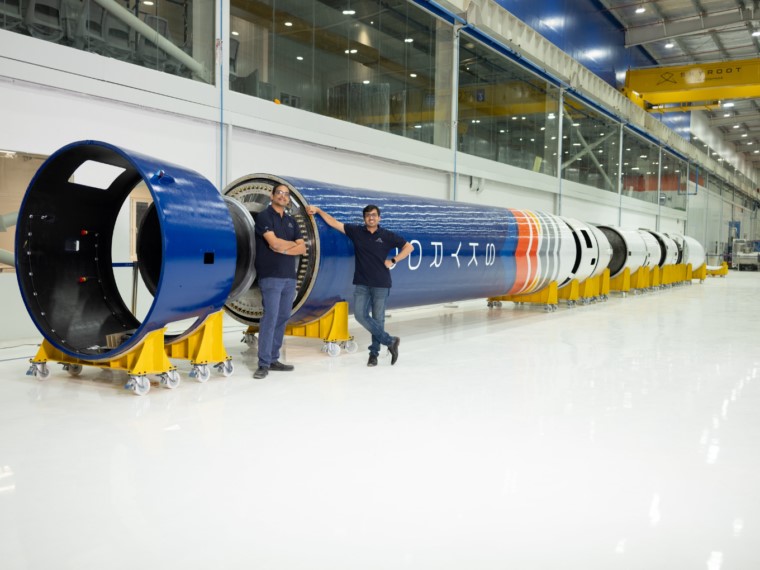
Vikram-I

27.10.2023
Vikram-I , Daily Current Affairs , RACE IAS : Best IAS Coaching in Kanpur
|
For prelims: Vikram-I,Vikram-S For mains GS paper 2 : Skyroot Aerospace,Significance of Skyroot Aerospace,Low Earth orbit (LEO Uses of LEOs |
Why in the news?
Indian firm Skyroot Aerospace recently unveiled its indigenously-built Vikram-1 rocket, Planned to be launched in early 2024.
About Vikram-I
- It will be Skyroot's second rocket, after the successful launch of the Vikram-S rocket on November 18 last year, when the space start-up became the first company to launch a private rocket from the ISRO’s launch centre in Sriharikota.
- Vikram-1, named after the father of India’s space programme, Vikram Sarabhai, is a multi-stage launch vehicle with a capacity to place around 300 kg of payloads in low-earth orbit.
- The rockets are developed with the aim of providing multi-orbit insertion and interplanetary mission capability to not just India but also foreign customers.
- It has been built by Hyderabad-based Skyroot Aerospace, a space startup.
- It is an all-carbon-fibre-bodied rocket that can place multiple satellites into orbit.
- The rocket also features 3D-printed liquid engines, a testament to Skyroot Aerospace's commitment to leveraging cutting-edge technology in its designs.
- Being a solid-fuel rocket and using relatively simpler technologies would mean that launching this vehicle would require minimal infrastructure and that the rocket could be assembled and launched within 24 hours from any site.
Vikram-S
- It is a single-stage sub-orbital launch vehicle.
- It will carry three customer payloads in a sub-orbital flight. Among the three payloads is a 2.5kg satellite of another space startup, Space Kidz India, which has been built by students from India, the US and Indonesia.
- Sub-orbital flight are those vehicles which are travelling slower than the orbital velocity, meaning it is fast enough to reach outer space but not fast enough to stay in an orbit around the Earth.
- It is roughly defined as a distance of more than 80 km from the Earth’s mean sea level.
- It will help test and validate technologies in the Vikram series space launch vehicles.
- The company is designing three Vikram rockets that will use various solid and cryogenic fuels to carry between 290 kg and 560 kg payloads to sun-synchronous polar orbits.
About Skyroot Aerospace:
- It is the national-award winning startup.
- It is building India’s first privately built space launch vehicles.
- The firm, founded by former scientists of the Indian Space Research organization (ISRO), is a 150 plus member strong team actively developing their flagship Vikram series of space launch vehicles, named after ISRO founder Vikram Sarabhai.
- Skyroot successfully demonstrated the country’s first privately developed cryogenic engine, Dhawan-1.
- The engine, which will be the upper stage in the Vikram-2 rocket, was completely 3D printed using a superalloy, with the process reducing the manufacturing time by 95 per cent.
Significance of Skyroot Aerospace
- It has been developing cutting-edge technologies for our space launch vehicles, such as carbon composites and 3D printing." And we have attempted to realize them within the Indian industry.
- It stated that manufacturing to required quality standards within timelines hampered by Covid-19 and other factors has been quite challenging in this journey.
- It is the first private rocket builder to launch in the Indian space sector.
A low Earth orbit (LEO)
- A low Earth orbit (LEO) is, as the name suggests, an orbit that is relatively close to Earth’s surface.
- It is an orbit around Earth with an altitude above Earth’s surface from 160 kms to 2,000 kilometers (1,200 miles).
- It is high enough to cross all the mountains and also high enough that atmospheric drag won’t bring satellites right back home again.
- It is worth mentioning that objects below approximately 160 kilometers (99 mi) will experience very rapid orbital decay and altitude loss.
- LEO satellites orbit closer to the earth, they are able to provide stronger signals and faster speeds than traditional fixed-satellite systems.
- Most satellites, the Space Shuttle, the International Space Station and the Hubble Space Telescope are also present in LEO. Most man made objects in space are in LEO. Most navigation satellites by the military are also in LEO.
Uses of LEOs
- LEO-based telecommunication systems provide cheap services to countries. It helps in providing satellite telephone service in hilly areas where it would be too costly or even impossible to lay land lines.
- It is used for things that we want to visit on our Space Shuttle, like the International Space Station (ISS), Hubble Space Telescope and other military and communication satellites.
- It also helps the country in having a close eye on the cross border activities through navigation satellites.
Source: India Today